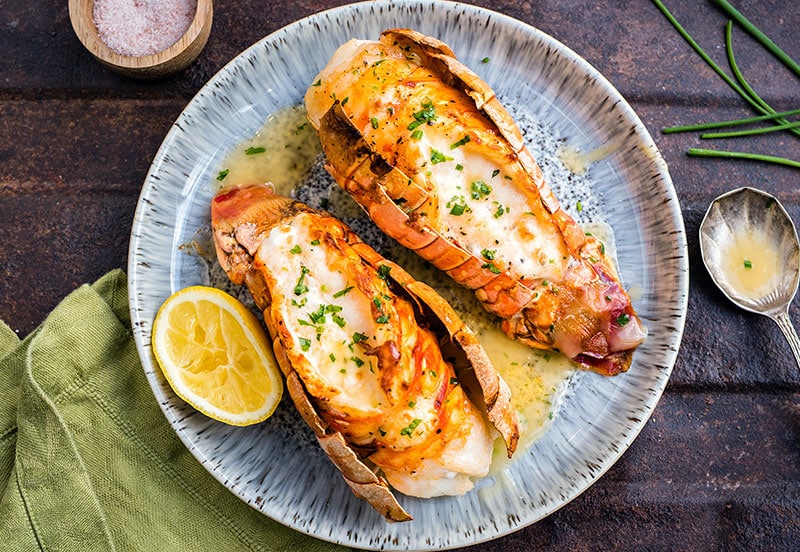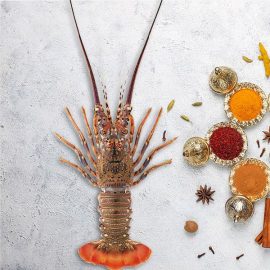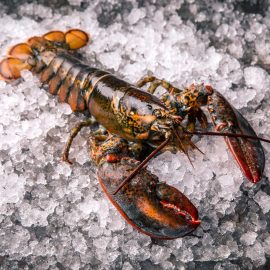
You want to be sure that your whole lobster is of the finest quality, just as you want that with your fresh fish and blast frozen fish. You should know how to choose the right lobster if you’re planning to make lobster rolls, bisque, and ravioli.
The flavour profile of rock lobster lends itself well to many types of cuisine, from grilling to currying.
Moreover, good news keeps coming: Not only do rock lobsters contain high levels of protein and Omega-3 nutrients, but they are also responsibly caught and cultivated – ensuring their survival into the future. Place your order now, add it to basket, and choose the delivery date of your choice.
What is Rock Lobster?
These are easy to spot. There are no claws on this fresh lobster. How do we refer to it? These crustaceans are known by a variety of names, including spiny lobsters, langoustine, crayfish, and crawfish.
Approximately 60 species of seafood are found in this category. Almost every coast in the world has them, although they are more often found in tropical waters. There are two well-known rock lobsters, in two genera, the Panulirus and Palinurus.
The meat of rock lobsters is very similar to that of clawed lobsters, but it has a huge advantage, the claws contain a lot less meat. The chef benefits from clawlessness in a variety of ways. Since rock lobster tails contain all the meat, the head is usually removed from the body. It is much easier to remove meat from a rock lobster tail compared to claws, as well as provides a higher yield of lobster meat per weight and long shelf life.
An oceanic treat, rock lobster is prized for its tender, sweet flesh, packed with a delicious taste that carries a salty aroma of the sea. When included in a meal, it makes for a great social amulet, is sure to please, and makes for a great memory.

Buying Tips
Lobsters come in two types
Lobsters come in hard-shelled and soft-shelled varieties. This depends on whether lobsters have been shed recently. Lobsters with soft shells are softer. These shells have sweeter meat and are easier to eat. In addition, they aren’t as robust as hard-shell lobsters, which makes them less mobile. The meat of hard-shell lobsters can be slightly firmer and richer in flavour.
Check out the underside
The lobster’s claws, particularly its underbody, are a vibrant red colour. New shells have clean claws. Old shells will have scratched surfaces from rubbing on rocks. Consequently, if they have shed recently, they will have a fairly clean shell that is not too scraped up.
The smell of a good lobster
There is no smell to worry about. When they are alive, they shouldn’t stink.
Don’t let it enjoy itself before you enjoy it!
After getting out of the water, lobsters begin eating themselves and consuming their nutrients, which is the meat’s flavour.
Once it stops receiving food, it starts eating its fat storage as a means of surviving. When it is unable to feed, it will start using its protein reserves. Hence, it’s recommended to eat it right after it comes out of the water.
Antenna size is essential
A trick to buying at the grocery store is to watch out for the fact that they eat one another’s antennae. It is usually easy to tell if a lobster has lived there for a while if its antennae are worn away. A lobster with very long antennae is what you are looking for.
It’s all about the location
Typically if you buy frozen lobster at a store that is relatively in the same region as the source, it’s going to be fresher. The place you buy lobster does not matter if it’s Canadian or Maine lobster varieties. Additionally, it depends on the season, the Canadian lobster is considerably less expensive at the beginning and end of the year, and it is cheaper for Maine lobsters in the middle season.
The sweetness comes from steaming
It is better to steam rather than boil. It is deliciously sweet and tastes better if you steam lobster rather than boiling it in water and olive oil.


